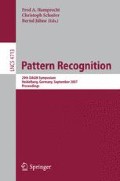Abstract
This contribution presents a novel approach to the challenging problem of model selection in motion estimation from sequences of images. New light is cast on parametric models of local optical flow. These models give rise to parameter estimation problems with highly correlated errors in variables (EIV). Regression is hence performed by equilibrated total least squares. The authors suggest to adaptively select motion models by testing local empirical regression residuals to be in accordance with the probability distribution that is theoretically predicted by the EIV model. Motion estimation with residual-based model selection is examined on artificial sequences designed to test specifically for the properties of the model selection process. These simulations indicate a good performance in the exclusion of inappropriate models and yield promising results in model complexity control.
Access this chapter
Tax calculation will be finalised at checkout
Purchases are for personal use only
Preview
Unable to display preview. Download preview PDF.
References
Black, M.J., Jepson, A.: Estimating multiple independent motions in segmented images using parametric models with local deformations. In: IEEE Workshop on Motion of Non-Rigid and Articulated Objects, pp. 220–227. IEEE Computer Society Press, Los Alamitos (1994)
Gheissari, N., Bab-Hadiashar, A., Suter, D.: Parametric model-based motion segmentation using surface selection criterion. Computer Vision and Image Understanding 102, 214–226 (2006)
Akaike, H.: A new look at statistical model identification. IEEE Transactions on Automatic Control 19, 716–723 (1974)
Schwarz, G.: Estimating the dimension of a model. Annals of Statistics 6(461), 464 (1978)
Wechsler, H., Duric, Z., Li, F.Y., Cherkassky, V.: Motion estimation using statistical learning theory. PAMI 26(4), 466–478 (2004)
Cootes, T.F., Thacker, N., Taylor, C.J.: Automatic model selection by modelling the distribution of residuals. In: Heyden, A., Sparr, G., Nielsen, M., Johansen, P. (eds.) ECCV 2002. LNCS, vol. 2353, pp. 621–635. Springer, Heidelberg (2002)
Jähne, B.: Digital Image Processing. In: Concepts. Algorithms and Scientific Applications, vol. 6, Springer, Berlin (2005)
Lucas, B., Kanade, T.: An iterative image registration technique with an application to stereo vision. In: DARPA Image Understanding Workshop, pp. 121–130 (1981)
Scharr, H.: Optimale Operatoren in der Digitalen Bildverarbeitung. PhD thesis, University of Heidelberg, Heidelberg, Germany (2000)
Van Huffel, S., Vandewalle, J.: The Total Least Squares Problem: Computational Aspects and Analysis. SIAM, Philadelphia (1991)
Mühlich, M.: Estimation in Projective Spaces and Application in Computer Vision. PhD thesis, Johann Wolfgang Goethe Universität Frankfurt am Main (2005)
Andres, B.: Model selection in optical flow-based motion estimation by means of residual analysis. Diploma thesis, University of Heidelberg (2007)
Author information
Authors and Affiliations
Editor information
Rights and permissions
Copyright information
© 2007 Springer-Verlag Berlin Heidelberg
About this paper
Cite this paper
Andres, B., Hamprecht, F.A., Garbe, C.S. (2007). Selection of Local Optical Flow Models by Means of Residual Analysis. In: Hamprecht, F.A., Schnörr, C., Jähne, B. (eds) Pattern Recognition. DAGM 2007. Lecture Notes in Computer Science, vol 4713. Springer, Berlin, Heidelberg. https://doi.org/10.1007/978-3-540-74936-3_8
Download citation
DOI: https://doi.org/10.1007/978-3-540-74936-3_8
Publisher Name: Springer, Berlin, Heidelberg
Print ISBN: 978-3-540-74933-2
Online ISBN: 978-3-540-74936-3
eBook Packages: Computer ScienceComputer Science (R0)

